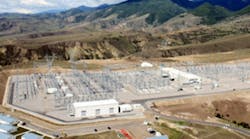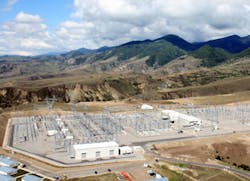Turkey has a growing demand for power. Georgia has an abundance of renewable power sources, such as hydro and wind. Georgia's grid network was not designed as a network for an independent state, as it was part of the power supply in the Caucasus that was linked to the Soviet republics. The challenge is to break down existing barriers across the boarders, connect different power supply networks of varying technical parameters (frequency, phasing), and stabilize power supply, while enabling the export of excessive power.
The Georgia-Black Sea Transmission Network project began in 2010 with support from the European Investment Bank, the European Bank for Reconstruction and Development, the German KfW Group, and the Development Bank of Austria. The ambitious project completed with a ceremony on December 11, 2013 with the minister of Georgia and the minister of Turkey in attendance, at the new substation in Akhaltsikhe, Georgia.
completed two back-to-back high-voltage direct current (HVDC) links at the Akhaltsikhe substation in southern Georgia close to the Turkish border, for Energotrans Ltd. The new back-to-back HVDC links feed a 400-kV overhead transmission line that connects to the Turkish 400-kV grid at the border. Each link transmits 350 MW of eco-friendly electric power, which is crucial for Turkey's growing power demand.
The three-phase alternating current of the one network is converted in the new converter substation into direct current and transmitted directly via a DC link to the inverter station. There, the direct current is converted back into three-phase current with simultaneous adjustment to the parameters of the network into which it is to be fed. This enables seamless interconnection of the two networks.
The Georgian network is based on a 500-kV system. The Georgia HVDC station converts power from 500- to 400-kV and back. The station operates on two back-to-back links, each line of which is able to transmit 350 MW of power. The line to Turkey is 151 km long, ending at Borchkha substation in Turkey.
The HVDC back-to-back links provide protection against cascading grid disturbances because it acts like an automatic firewall, which can control stops and restarts of the transport of electric power.
Georgia is working to establish membership in the European Network of Transmission System operators for Electricity (ENTSO-E) with the expectation of exporting electricity to other EU countries, made possible by this new transmission solution.
Power Transmission and the associated service are part of Siemens' Environmental Portfolio. Around 43 percent of its total revenue stems from green products and solutions. That makes Siemens one of the world's leading providers of eco-friendly technology.

Voice your opinion!
Voice your opinion!
To join the conversation, and become an exclusive member of T&D World, create an account today!
Latest from Substations
Latest from Substations


